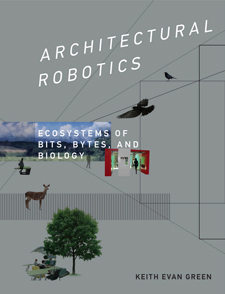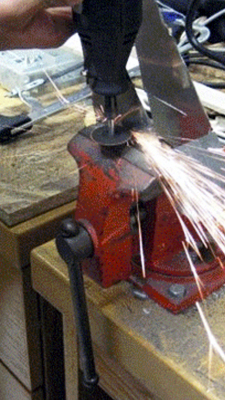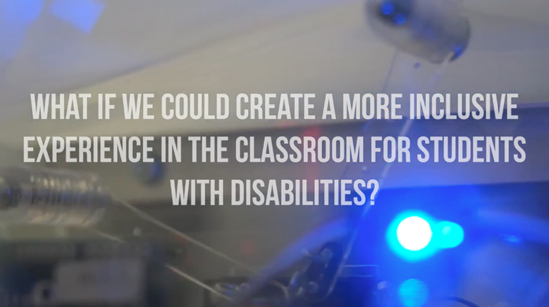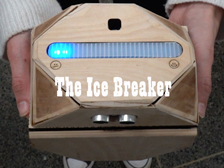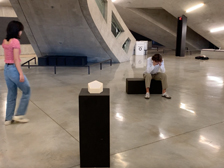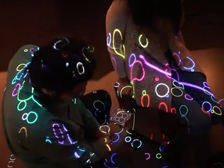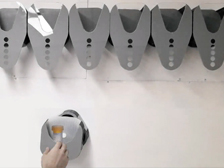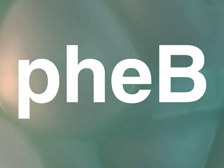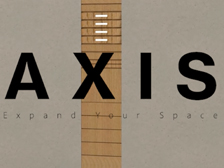 |
|||||||||
 |
 |
 |
 |
 |
 |
 |
|||
p r o t o t y p i n g (link) p o s t e r s & v i d e o s (link) c o u r s e p o l i c i e s (link) c o u r s e c u l t u r e (link) d e s i g n m e t h o d s
S T U D E N T E X A M P L E S
|
|
Architectural Robotics C O U R S E D E S C R I P T I O N | D E A 6 2 1 0 P R E R E Q U I S I T E S | E N R O L L M E N T S Y L L A B U S | S E E A L S O M Y D E A 5 2 1 0 & D E A 2 7 3 0 Outcome 1: To understand the design, technical, social, ecological, and ethical challenges and opportunities of architectural robotics. This course is designed to guide you in designing meaningful solutions, while also encouraging exploration of who we are, how we engage with the world, and our place within it. "In order to understand things, we have to build them." H I S T O R Y O F T H I S C O U R S E - - - - - - - - - - - - - - - - - - - - - - - - - - - - - - The pedagogy of this course has been the subject of my paper presented at ICRA (the IEEE International Conference on Robotics and Automation) and my paper published in RAM (IEEE Robotics and Automation, Rethinking the Machines in Which We Live.) I also co-authored, with Mark Gross, an overview of Architectural Robotics for ACM interactions. Required reading for this course, my book, Architectural Robotics: Ecosystems of Bits, Bytes, and Biology (MIT Press), establishes this subfield at the intersection of robotics, (environmental) design, and psychology. I N T R O D U C T I O N - - - - - - - - - - - - - - - - - - - - - - - - - - - - - - - - - - - - - - - - - - - - Unlike a conventional building that has a limited range of designed responses to dynamic, changing conditions, architectural robotic environments are intimately bound together with their users and local conditions in a designed performance. More practically, architectural robotics is defined by the movement of physical mass and by its interactivity with and adaptivity to things outside it (e.g. people, other living things, objects, information). The prospect of this kind of environment was anticipated some fifty years ago by MIT Media Lab founder Nicholas Negroponte in his vision of “a man-made environment that responds to and is ‘meaningful’ for him or her” [5]. Wired editor Kevin Kelly later imagined a “world of mutating buildings” and “rooms stuffed with co-evolutionary furniture” [3]. And while Bill Gates envisions “a robot in every home” [2], William Mitchell, the late Dean of MIT’s School of Architecture and Planning and director of its Media Lab, envisioned homes “as robots for living in” [4]. Architectural Robotics meanwhile raises such critical questions as:
Architectural Robotics must go beyond simplistic formal achievements; it must strive to improve life, enhance existing places, and support human interaction. For philosopher Andrew Feenberg, “technology is not simply a means but has become an environment, a way of life” [1]. Architectural Robotics is more than an aesthetic search, a stylistic possibility, or a technological quest; it is, instead, a way to develop new possibilities for dwelling in support of and augmenting people and their surroundings. References T H E P O W E R O F A S M A L L C L A S S - - - - - - - - - - - - - - - - - - - - - - - - - Unlike a large lecture class at Cornell, this small class offers a unique opportunity for meaningful conversation, discovery, and collaboration. Don’t miss out on this chance to engage! To ensure attendance, a sign-in sheet will be available during the first ten minutes of each session. Additionally, a significant portion of your grade will be based on your active participation in collaborative learning and discovery. R E Q U I R E D R E A D I N G S - - - - - - - - - - - - - - - - - - - - - - - - - - - - - - - - - - - - - Readings for each class meeting are listed in the CLASS SCHEDULE (below). Please read the readings ahead of their assigned class session.
O P T I O N A L R E A D I N G S - - - - - - - - - - - - - - - - - - - - - - - - - - - - - - - - - - - - - • Alexander, C., et al. 1977. A Pattern Language (excerpts). Oxford. • Every student, beginning Week 02, will upload to our shared Box folder, ahead of that class meeting, a one-page Word document that includes the following for each assigned reading: • One student will be assigned one reading for a given class meeting and will present this reading in class. Here is a good example of slides prepared tor a presentation for this course. This presentation should conclude with the presenter sharing with us the most compelling questions submitted by student peers in their reviews found in the shared folder. 3. Students (for assignment 1) and student teams (for assignment 2) will present status reports and demos on their design activities, as per the weekly schedule (below) under the heading, "In class." Your status report can be a physical model, a powerpoint slide, a digital image (e.g., a 3D model), a Word document, or any other document that communicates the status of design development. For demos, you simply share your current physical prototype; or, you can take a smartphone video of your working prototype, upload the video (or a URL to it) to our shared folder, and share the video with us. (Sharing the video is a good approach, as robotics demos often fail!) Reports are uploaded to the shared class folder ahead of class presentations. About class organization, more broadly, please also review course culture: link. S C H E D U L E B Y W E E K - - - - - - - - - - - - - - - - - - - - - - - - - - - - - - - - - - - SHOP TRAINING: We will also do D2FS shop training to learn how to use the basic power tools safely. Please come to this training session with close-toe shoes (no sandals) and something to tie-back long hair if you have long hair! STUDENT CRITICS: Each class session, two student critics-of-the-day will be selected randomly to offer feedback on developing work from other students or teams. This is a critical aspect of this course: we learn from each other! METHODS: See top-left of this page for more on the human-centered design methods identified below (e.g., scenarios, ...) I N T R O Week 01 | 01.21 D2FS SHOP TRAINING Week 02 | 01.26 INTRO TO THE COURSE; GROVE ARDUINO PROTOTYPING Week 03 | 02.02 SCENES FROM A MARRIAGE P A R T - 1 | C O N C E P T S Week 04 | 02.09 PATTERNS - I Week 06 | 02.23 INTERACTIONS P A R T - 2 | S C A L E S & I M P A C T S Week 08 | 03.09 HABIT-ATIONS > NO CLASS MONDAY | Fall Break Week 09 | 03.16 WORKSTATIONS - - - - - - - - - LAST DAY TO DROP/CHANGE GRADE OPTION | 03.16 - - - - - - - - - - - - Week 10 | 03.23 LIVING ROOMS & FURNISHINGS - I Week 11 | 03.30 SPRING BREAK Week 12 | 04.06 LIVING ROOMS & FURNISHINGS - IILIVING ROOMS & FURNISHINGS - II Week 13 | 04.13 PORTALS TO ELSEWHERE Week 14 | 04.20 ECOSYSTEMS OF BITS, BYTES, & BIOLOGY P A R T - 3 | M O V I N G & T H I N K I N G Week 15 | 04.27 | INTELLIGENT? Final Class | 12.06 Refined Prototypes, Assignment-2 [10 pts]. xx.xx | xxpm | DEADLINE: TEAM REPORT & VIDEO, uploaded for final grading: A S S I G N M E N T S - - - - - - - - - - - - - - - - - - - - - - - - - - - - - - - - - - - - - - - - - - - - - The first assignment, undertaken by each student, is intended to be a fast-paced engagement. The second assignment is undertaken by teams of 2-4 students and provides a longer, deeper development of the design following a trajectory like this:
Team composition for the second assignment will be formed by the instructor(s) based partly on proposals pitched in class by class members. Keep in mind: this course asks you to develop architectural robotic artifacts that have at least one input and one output which moves physical mass. - - - - - - - - - - - - - - - - - - - - - - - - - - - - - - - - - - - - - - - - - - - - - - - - - - - - -- - - - - - - - - -
The first image - the "empty room" - in Here by Richard McGuire. Assignment-1 | An interactive box offering temporal and emotional connectivity. The first assignment will take inspiration from Richard McGuire graphic novel, Here (1989). The book presents the same location in space at different points in time --mostly a living room in a home (this room, empty, is pictured above). Using the Grove kit you are provided, develop an interactive, physical table, stool, or bench at a model scale that enables or augments one or more of Here's characters, in that room, at a single instance shown in one pair of pages (one image of the room) from Here. To get us started quickly (while you are waiting for your copy of Here to arrive), use one of the following five instances of the room from the book: Here, 1933, holding hands and hanging a picture You will be asked to write a scenario that offers the circumstances (regrets, wishes, gratitude, loss, ...) of the person or people you are designing for, addressing the themes of time, memory, and human connection. Practically, you will develop an interactive device that offers a minimalist yet expressive way to communicate time, memory, and connection through simple hardware components. The focus here is on using limited hardware and physical materials to create a meaningful interaction between the past and present, whether it’s through gradual transitions, feedback loops, and/or symbolic physical movement. The kind of artifact you are striving for is small in scale, whimsical/poetic, beautifully fabricated (in hi-fidelity), interactive in simple ways, and meaningful and purposeful. You are encouraged to construct your box enclosure from the corrugated plastic panels provided in class. If you need a different size or shaped corrugated plastic enclosure, or if you wish to cut-out or engrave the surfaces of the panels, or if wish to use MDF or acrylic instead of corrugated plastic, work with our partners in the D2FS on laser-cutting panels to-size from digital files you generate using CaseMaker. In any case, your finished product must not have ink-pen writing or coloring on it, or use craft materials like cotton balls or craft paper; any inscriptions should be subtracted by laser-cutter engraving; color should come from the LED stick provided. You are permitted (and even encouraged) to cut material away from the panels by laser-cutter or mat knife. You may also add on to your box other features that are meticulously fabricated and purposeful. The battery pack provided must go inside your box with all your electronics; design an elegant way for users to recharge the device. You do not have to generate code on your own: you can select one of the codes provided under the heading below, “Arduino Codes You Can Copy & Paste.” (An effective way to tailor your code to your wants without coding experience is to use ChatGPT as described below.) "Design is the process of creating solutions within constraints." Limit yourself to using only the Grove electronics and box panels provided. Ensure that the battery and all electronics fit inside the box, and that the battery is accessible for recharging. If you diverge from the panels provided, generate your cut-files using CaseMaker and work with the D2FS to have these cut. Don't make the mistake of creating a prototype that is not meticulously designed and fabricated; prototypes that look like craft projects created by a child will be graded accordingly. Intellectually, your "small" assignment may take inspiration from the boxes of artist Joseph Cornell (one such box is in Cornell's Johnson Museum of Art), the words of Brian Eno (producer of, e.g., Coldplay's "Viva La Vida", ambient music pioneer, and member or the band Roxy Music), and three perspectives on affective computing / designing for emotion:
- - - - - - - - - - - - - - - - - - - - - - - - - - - - - - - - - - - - - - - - - - - - - - - - - - - - - - - - - - - - - - Assignment 2 | "Repairing 'Stellavista' (45% of your grade; team effort) Read J G Ballard's short story, "The Thousand Dreams of Stellavista" (1962). Inspired by Ballard's story, design a module 8' wide x10' deep x 8' high that you insert in a hotel room (this one from Marriott for which we have a scale model) that repairs something you discover in Ballard's fictionalized suburban, architectural-robotic dystopia. Essentially, Architectural Robotics that are going wrong in Ballard's story you will make "right" in the space of a 10'x8'x8' module within a Marriott hotel room. Your user/clients are Fay and Howard Talbot, the couple in the story that purchases and moves into a home in Stellavista. Imagine your hotel room as Fay and Howard's place-of-stay while they shop for their new home. Write a paragraph that you insert strategically in Ballard's story that describes this hotel room and how it fosters a better future for Fay and Howard, a couple in distress, amplified by living in their new home. The starting point for your design is the Robot Room under development in my Architectural Robotics Lab. Imagine that one wall and part of the floor of your prototype will be "covered" with hinging panels as seen in the Robot-Room video. In concept, this robot surface is a strip of paper, folded multiple times across its width to create hinges. Your task is to add two elements to this robotic wall and (partial) floor surface of hinged panels: • one free-standing robotic furnishing (see, e.g., these robotic furnishings) The system -- the hinged wall-floor robot + your two elements -- is your design space for best accommodating Howard and Faye. You are welcome to add other more incidental elements as your choose. The hotel room is this one from Marriott. You can chose any scale for your working prototype. If you wish, you can use the scale model we have in our teaching space, scaled to 1 ft. = 2 inches to match a 12-inch wooden human figures you can purchase, for instance, here ($6.99) that you might use in your videos and documents. You can alternatively print images of people found in Google images and adhere these printed figures to cardboard backing. However, the scale of the model may be too small for you to explore your design. The prototype should be interactive by way of sensors and actuators that move physical mass, You are encouraged to add lighting and/or sound. You may use the Grove kit for this assignment; you have the option of using any additional means listed above for Assignment 1. G R A D I N G / G R A D I N G R U B R I C - - - - - - -- - - - - - - - - - - - - - - - - - - - - Please review carefully the Course Policies (link). These policies are not negotiable except under grave circumstances. Throughout this course—an intimate and intensive “conversation” across students and the professor— students will have ample opportunity to receive feedback on their work. Here is rubric for the two major assignments. The list that follows names and describes the graded components for this course. Each component is worth so many points, as shown in red type. The sum of all of these components equals the final grade of 100 points. The numerical scale for grading is as follows: A+ (98–100), A (93–97), A- (90–92), B+ (88–89), B (83–87), B- (80–82), C+ (78–79), C (73–77), C- (70–72), D+ (68–69), D (65–67), D- (below 65). • ATTENDANCE + PARTICIPATION | 20 points
You will lose 5 points each time we call on you and you are not present (if you have no approved excuse) or you are otherwise unresponsive, distracted by things on your phone, computer, or in-class conversations unrelated to this course. • ASSIGNMENTS [rubric] | 35 points (A-1) & 45 points (A-2)
|
|
||||||
 |
|||||||||
|
|
|
|
|
|
|
|
|
|
|
